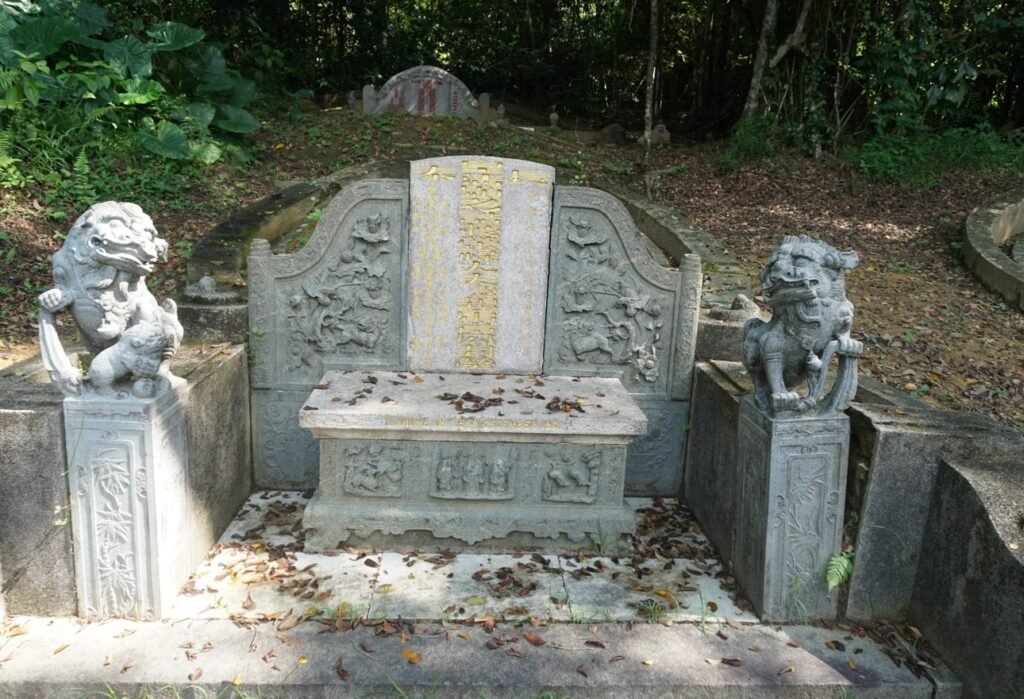17 CHEANG HONG LIM CLUSTER
The Fortunes of the Cheang Family
CHEANG JIM SONG 章壬松,(Unknown–1918) YEO KUM NEO 楊甘娘 (Unknown–1921)
KHOO BENG CHOO 邱明珠 (1884–1926) SEOW SIOK NEO 蕭椒娘 (Unknown–1931)
Place of Ancestry: Tio Thua (長泰)
Cheang Hong Lim, the scion of the Cheang clan, was endowed with such immense wealth that the family could afford large private burial grounds. Despite this, the march of urbanisation meant that many family members had to be reinterred in 1935 in different clusters within Bukit Brown Cemetery. Finally, Cheang himself was relocated in 1961 by his eldest son’s daughter, Muriel Cheang, from a family burial site in Alexandra to Bukit Brown. The family owed much of its wealth to Cheang’s business acumen. Cheang (1841-1893) made a fortune from opium and spirit farms, and had risen by the late 1860s to the top ranks of the colony’s richest and most powerful Chinese leaders of the 19th century.
This rapid wealth accumulation occurred just a few short years after his father Cheang Sam Teo died in 1862. Although only 37 at the time, the younger Cheang managed to diversify the lucrative opium business into real estate and shipping. His ownership of properties in Chinatown stretched from Chin Swee Road to Havelock Road. Such was his wealth that a popular saying at the time went – “one may have Cheang’s wealth but will never match the properties in his possession” (”有章芳琳的富,没有章芳琳的厝“).
What marks Cheang from the rich scions of his days was his generous donation to causes outside the narrow confines of his clan. He donated towards the building or repair of at least five temples across the dialect divide. Today’s Hong Lim Park is the result of his biggest donations in 1876, a sum of $3,000 for a public park and he even hired two gardeners to look after it He also donated a fire brigade and ran a free school for many years. By 1891, he was officially recognised by the colonial authority as the de facto head of the largest and richest clan in Singapore – the Hokkiens. At the time of his passing in 1893, he left a $100,000 legacy for charitable causes and effectively wrote off $400,000 worth of debt owed to him by others.
It is not without bitter irony that both his father’s and his wills would be disputed in the court of law. In the case of the former, his brother alleged, but failed to prove, that Cheang Hong Lim forged his father’s will. In the latter, a son-in-law disputed the contents of the will.
Ultimately, Cheang left a mixed legacy – whilst he clearly enriched the religious, cultural and infrastructural foundations of Singapore, the level of opium addictions was such that the earnings from consumption became the single largest revenue source for colonial Singapore at the turn of the 21 century.
For his family, he ensured that money also came with status to complete his legacy. He managed to purchase official titles for key family members from the Qing government, which needed funds to fill its empty coffers. Unsurprisingly, Cheang bought himself a first ranking title, which is carved in stone on his tomb in another location at Bukit Brown.
His tomb was relocated to Block 4, division C on 26 December, 1961 with a special permit.
by Fabian Tee


Recent Comments